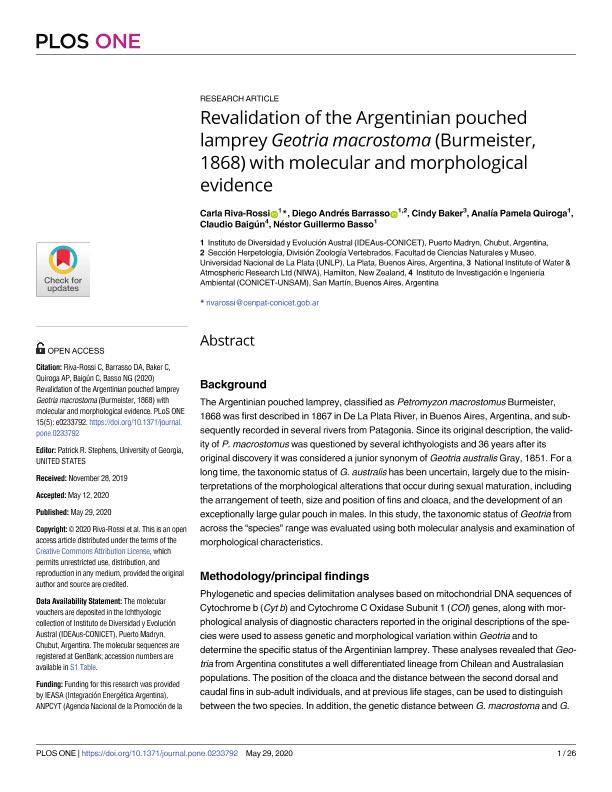Artículo
Revalidation of the Argentinian pouched lamprey Geotria macrostoma (Burmeister, 1868) with molecular and morphological evidence
Riva Rossi, Carla Marcela ; Barrasso, Diego Andrés
; Barrasso, Diego Andrés ; Baker, Cindy; Quiroga, Analía Pamela
; Baker, Cindy; Quiroga, Analía Pamela ; Baigún, Claudio Rafael M.
; Baigún, Claudio Rafael M. ; Basso, Nestor Guillermo
; Basso, Nestor Guillermo
 ; Barrasso, Diego Andrés
; Barrasso, Diego Andrés ; Baker, Cindy; Quiroga, Analía Pamela
; Baker, Cindy; Quiroga, Analía Pamela ; Baigún, Claudio Rafael M.
; Baigún, Claudio Rafael M. ; Basso, Nestor Guillermo
; Basso, Nestor Guillermo
Fecha de publicación:
05/2020
Editorial:
Public Library of Science
Revista:
Plos One
ISSN:
1932-6203
Idioma:
Inglés
Tipo de recurso:
Artículo publicado
Clasificación temática:
Resumen
Background The Argentinian pouched lamprey, classified as Petromyzon macrostomus Burmeister, 1868 was first described in 1867 in De La Plata River, in Buenos Aires, Argentina, and subsequently recorded in several rivers from Patagonia. Since its original description, the validity of P. macrostomus was questioned by several ichthyologists and 36 years after its original discovery it was considered a junior synonym of Geotria australis Gray, 1851. For a long time, the taxonomic status of G. australis has been uncertain, largely due to the misinterpretations of the morphological alterations that occur during sexual maturation, including the arrangement of teeth, size and position of fins and cloaca, and the development of an exceptionally large gular pouch in males. In this study, the taxonomic status of Geotria from across the "species" range was evaluated using both molecular analysis and examination of morphological characteristics. Methodology/principal findings Phylogenetic and species delimitation analyses based on mitochondrial DNA sequences of Cytochrome b (Cyt b) and Cytochrome C Oxidase Subunit 1 (COI) genes, along with morphological analysis of diagnostic characters reported in the original descriptions of the species were used to assess genetic and morphological variation within Geotria and to determine the specific status of the Argentinian lamprey. These analyses revealed that Geotria from Argentina constitutes a well differentiated lineage from Chilean and Australasian populations. The position of the cloaca and the distance between the second dorsal and caudal fins in sub-adult individuals, and at previous life stages, can be used to distinguish between the two species. In addition, the genetic distance between G. macrostoma and G. australis for the COI and Cyt b mitochondrial genes is higher than both intra-and inter-specific distances reported for other Petromyzontiformes. Conclusions/significance Our results indicate that the Argentinian pouched lamprey, found along a broad latitudinal gradient on the south-west Atlantic coast of South America, should be named as Geotria macrostoma (Burmeister, 1868) and not as G. australis Gray 1851, returning to its earliest valid designation in Argentina. Geotria macrostoma can now be considered as the single lamprey species inhabiting Argentinian Patagonia, with distinct local adaptations and evolutionary potential. It is essential that this distinctiveness is recognized in order to guide future conservation and management actions against imminent threats posed by human actions in the major basins of Patagonia.
Palabras clave:
POUCHED LAMPREY
,
PATAGONIA
,
SANTA CRUZ RIVER
,
EDEMISM
Archivos asociados
Licencia
Identificadores
Colecciones
Articulos (IIIA)
Articulos de INSTITUTO DE INVESTIGACION E INGENIERIA AMBIENTAL
Articulos de INSTITUTO DE INVESTIGACION E INGENIERIA AMBIENTAL
Articulos(IDEAUS)
Articulos de INSTITUTO DE DIVERSIDAD Y EVOLUCION AUSTRAL
Articulos de INSTITUTO DE DIVERSIDAD Y EVOLUCION AUSTRAL
Articulos(SEDE CENTRAL)
Articulos de SEDE CENTRAL
Articulos de SEDE CENTRAL
Citación
Riva Rossi, Carla Marcela; Barrasso, Diego Andrés; Baker, Cindy; Quiroga, Analía Pamela; Baigún, Claudio Rafael M.; et al.; Revalidation of the Argentinian pouched lamprey Geotria macrostoma (Burmeister, 1868) with molecular and morphological evidence; Public Library of Science; Plos One; 15; 5; 5-2020; 1-26
Compartir
Altmétricas



